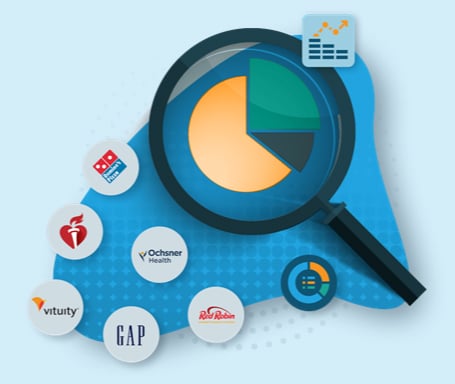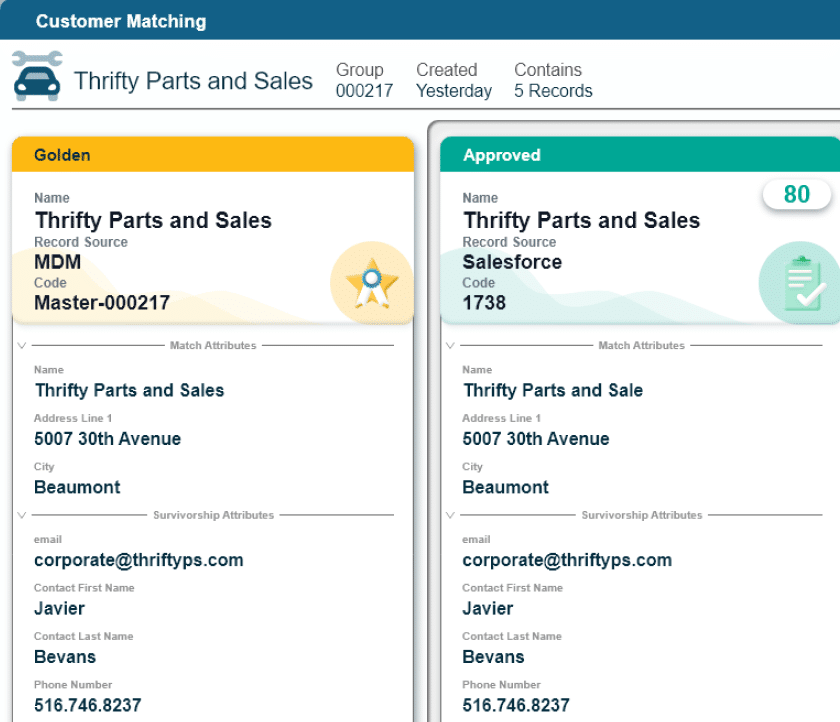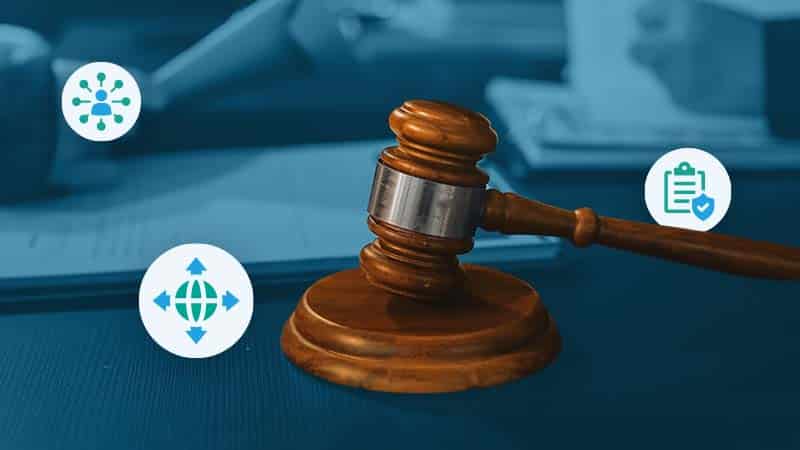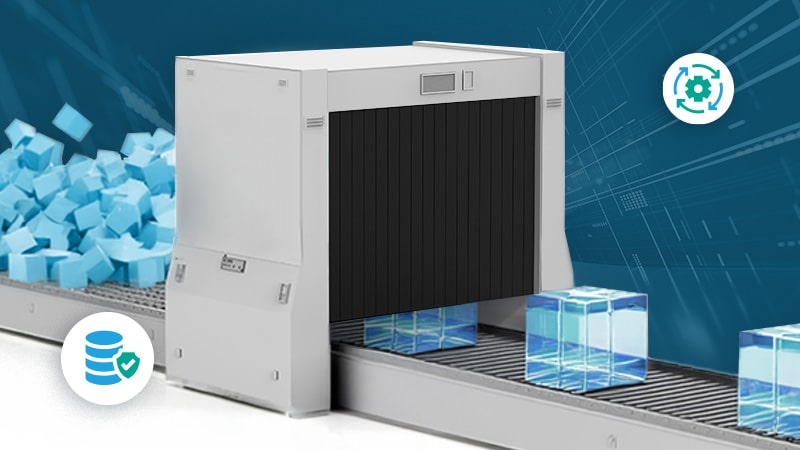Table of Contents
- Why Data Standardization Matters
- Key Components of Data Standardization
- Common Data Types and Relevant Standards
- The Business Impact of Data Standardization
- Data Standardization vs. Data Normalization
- Benefits of Data Standardization
- Challenges and Considerations for Data Standardization
- Data Standardization Best Practices
- Data Standardization Tools
- Implementing Data Standardization with Profisee MDM
- Start on the Path to Data Standardization Today
Data standardization is the process of transforming raw data into a uniform format or structure, ensuring consistency and conformity to predefined rules. In this blog post, we’ll explore what data standardization is, why it matters and how it can benefit organizations of all sizes.
Why Data Standardization Matters
Data standardization matters because businesses rely heavily on accurate and reliable data to make informed decisions. However, organizations often obtain enterprise data from various sources and in different formats, leading to inconsistencies and inaccuracies that hinder enterprise analytics, advanced AI applications and more.
The process of data standardization involves cleansing data to eliminate errors, inconsistencies and redundancies. By standardizing data, organizations can improve data quality, accuracy and reliability, laying a trusted foundation for effective decision-making and operational efficiency.
Key Components of Data Standardization
Effective data standardization encompasses various components, including formatting, naming conventions and data categorization.
Establishing consistent data models and schemas is essential for harmonizing disparate data sources and enabling seamless integration across systems. Moreover, clear data governance policies and procedures are crucial for maintaining standardized data over time, ensuring ongoing data quality and consistency.
Common Data Types and Relevant Standards
Data standardization involves ensuring consistency not only in formatting and structure but also in the types of data being captured and processed. Here are some common data types encountered in address data and the relevant standards used to standardize them.
Street Names
Standardizing street names is crucial for ensuring consistency and accuracy in address data. Poor-quality data with variations in street names — such as “main street” versus “Main St” — can lead to confusion and errors in data processing and analysis.
By adhering to the United States Thoroughfare Standard (USTS) for street names, organizations can eliminate discrepancies and ensure that addresses are uniformly formatted, making it easier to match, search and validate address data across different systems and applications.
Unit Designations
Consistent formatting of unit designations — such as apartment numbers, suite numbers and unit identifiers — is essential for precise address identification and delivery. Non-standardized unit designations, like “apt 2” versus “Apt 2,” can result in delivery errors and miscommunication.
Adhering to standardized formats prescribed by postal addressing standards like the Postal Addressing Standards ensures clarity and accuracy in unit designations, improving mail delivery efficiency and customer satisfaction while reducing data entry errors and operational costs.
City Names
Standardizing city names is vital for ensuring accuracy and reliability in address data. Inconsistent city name formatting — such as — can hinder data matching and validation processes, leading to inaccuracies in customer records and mail delivery.
By following postal addressing standards for city names, organizations can eliminate ambiguities and discrepancies, ensuring that addresses are correctly identified and processed, regardless of the source or destination.
State Abbreviations
Consistent formatting of state abbreviations is essential for accurate address validation and routing. Non-standardized state abbreviations, like “Miss.” versus “MO,” can cause errors in address matching and geocoding, leading to delivery delays and misrouted mail.
Adhering to postal addressing standards for state abbreviations ensures uniformity and precision in address data, facilitating seamless integration and interoperability across different systems and platforms.
Postal Codes
Standardizing postal codes is critical for ensuring precision and efficiency in address data management. Inaccurate or non-standardized postal codes, such as “12345” versus “12345-6789,” can result in undeliverable mail and customer dissatisfaction.
By adhering to postal addressing standards for postal codes, organizations can ensure that addresses are correctly validated, routed and delivered, minimizing errors and enhancing the overall reliability of address data.
Note that some organizations use commercial, third-party data and address verification services to identify and address gaps in location data and ensure compliance with published standards.
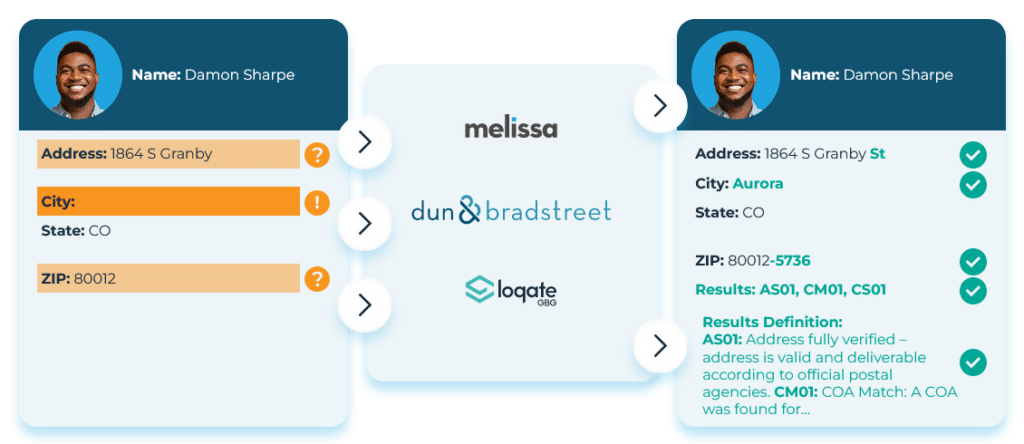
The Business Impact of Data Standardization
By examining examples of poor-quality data alongside their standardized counterparts, you can see the tangible benefits of adhering to data standards.
This comparison highlights the importance of uniformity and consistency in data formats, particularly in critical areas such as address management. In the context of address data, standardization ensures precision, accuracy and compatibility across systems, facilitating seamless operations and enhancing customer experiences.
The table below presents a side-by-side comparison of poor-quality address data and their standardized equivalents, showcasing the significant impact of data standardization on data quality and reliability.
| Data Type | Importance of Data Standardization | Example of Poor-Quality Data | Relevant Data Standard | Example of Standardized Data |
|---|---|---|---|---|
| Street Names | Ensures consistency and accuracy in address data, facilitating matching and validation. | "main street," "elm st." | United States Thoroughfare Standard | "Main St," "Elm St" |
| Unit Designations | Enhances address identification and delivery precision, reducing errors and improving efficiency. | "apt 2," "suite #300," "unit b" | Postal Addressing Standards | "Apt 2," "Ste 300," "Unit B" |
| City Names | Eliminates ambiguities and discrepancies in address data, ensuring correct identification and routing. | "NYC," "LA" | "New York," "Los Angeles" | |
| State Abbreviations | Facilitates accurate address validation and routing, minimizing delivery delays and misrouted mail. | "ny," "ca," "il" | "NY," "CA," "IL" | |
| Postal Codes | Improves efficiency in address data management by ensuring precision and reliability in postal codes. | "12345," "90210," "60601" | "12345-6789," "90210-1234," "60601-1234" |
Data Standardization vs. Data Normalization
In the realm of data management, it’s essential to distinguish between data standardization and data normalization. While both processes aim to enhance data quality and consistency, they serve distinct purposes and operate at different levels.
Data Standardization
Data standardization involves transforming data into a consistent, common format according to predefined rules. It focuses on establishing consistency across various data elements, such as formatting, naming conventions and categorization.
Standardization facilitates data integration, interoperability and reliable analysis by providing a consistent framework for data interpretation and usage.
Data Normalization
On the other hand, data normalization primarily deals with organizing and optimizing data within databases to minimize redundancy and improve efficiency. It involves breaking down complex data structures into smaller, manageable units and establishing relationships between them.
Normalization techniques, such as the First Normal Form (1NF) or Third Normal Form (3NF), ensure data integrity and reduce anomalies like data duplication or update anomalies. For instance, in a customer database, normalization may involve separating customer information into distinct tables like “customers,” “addresses” and “orders,” linked by unique identifiers.
Both data standardization and normalization play critical roles in data management, contributing to improved data quality, reliability and usability.
Benefits of Data Standardization
There are several business benefits of data standardization. By enhancing data quality, organizations can reduce errors, improve data accuracy and improve trust in the data.
Facilitating interoperability enables seamless data exchange and integration, empowering organizations to leverage data assets more effectively. Moreover, standardized data supports informed decision-making, providing reliable insights for strategic planning and operational optimization.
Ultimately, data standardization streamlines processes, improves productivity and reduces operational costs, driving business success.
Below are a few discrete benefits of data standardization:
Improves Data Quality
Data standardization helps eliminate redundancies, errors and inconsistencies, resulting in higher data quality. By ensuring data is accurate, clean and consistent, organizations can have confidence in their decision-making process.
Enables Data Integration
In today’s interconnected business landscape, organizations often need to integrate data from multiple sources, such as customer records, product information and transactional data. Data standardization facilitates seamless data integration by providing a unified view across different systems and applications.
Enhances Data Analysis
One of the most common use cases of data standardization is to facilitate insightful, trusted analytics across the enterprise, regardless of the source system. Standardized data simplifies data analysis and reporting. With consistent data formats and structures, organizations can easily perform data analysis, generate meaningful insights and make data-driven decisions.
Supports Regulatory Compliance
Data standardization plays a vital role in meeting regulatory requirements and compliance standards. By ensuring data consistency and accuracy, organizations can comply with data protection regulations, industry standards and legal obligations.
Improves Operational Efficiency
Standardized data streamlines business processes, reduces manual data manipulation efforts, and minimizes data-related errors. This, in turn, improves operational efficiency, saves time and reduces costs associated with data management.
Challenges and Considerations for Data Standardization
Despite its numerous benefits, implementing data standardization can pose challenges. Legacy systems, data silos and cultural resistance may hinder adoption efforts.
Overcoming these obstacles requires stakeholder buy-in, organizational alignment and effective change management strategies. Additionally, ongoing monitoring, maintenance and adaptation to evolving business requirements are essential for sustaining data standardization initiatives, though commercial master data management (MDM) platforms help automate and maintain data standardization efforts over time.
Data Standardization Best Practices
Data standardization is essential for maintaining accurate, consistent data across your organization. By following best practices, you can streamline the process and ensure your data remains reliable. Here are some key practices to consider.
Implement Data Governance
When using a master data management (MDM) tool like Profisee, ensure your data standardization efforts align with your data governance policies. Data governance provides the rules and guidelines that define how data should be structured, validated and maintained to meet the organization’s standards for what constitutes good quality or useful data. Establishing clear ownership and accountability for data helps ensure consistency across all systems. Regular audits and updates to your governance policies will further enhance your data quality.
Use Workflow Automation
A robust MDM solution often includes workflow automation features that can significantly accelerate the data standardization process. Once you’ve identified the data that needs to be standardized and mapped out the steps for standardization, automation can handle repetitive tasks with minimal manual effort. This not only saves time but also reduces the risk of human error, ensuring more consistent results.
Adopt Data Validation
Preventing poor data quality at the point of entry is one of the most effective ways to maintain standardized data. Implement data validation rules to enforce your governance policies from the outset. By incorporating validation checks within your data entry systems, you can ensure data adheres to required formats, values and standards before it reaches downstream applications. This proactive approach minimizes the need for later cleanup and reduces operational inefficiencies.
Remove Duplicate Records
Duplicate records can lead to data inconsistencies and reporting errors. Most MDM tools, including Profisee, offer automated matching and deduplication features that help identify and merge duplicate records. Before standardizing your data set, use these capabilities to clean up duplicates. Additionally, apply survivorship rules to ensure the most accurate and up-to-date information is retained.
Use the Right Tools
Choosing the right tools is critical to successful data standardization. While an MDM solution like Profisee offers a comprehensive approach to managing and standardizing data, you may also use specialized tools depending on your organization’s specific needs. Evaluate tools based on their automation capabilities, ease of integration and support for your data governance framework. With the right technology in place, your standardization efforts will be more efficient and effective.
Data Standardization Tools
Selecting the right data standardization tool is essential for achieving accurate and consistent data. Here are some of the top tools to consider.
Profisee
Profisee is a leading best-of-breed MDM platform designed for enterprise-scale master data management. It offers robust data standardization features, including automated workflows, data validation and deduplication. Profisee also integrates seamlessly with other business software tools — especially within the Microsoft ecosystem — making it a versatile choice for organizations aiming to implement comprehensive data governance.
Alteryx Designer
Alteryx Designer is a powerful data preparation tool that supports data standardization through its low-code/no-code interface. Its data cleansing, transformation and enrichment capabilities enable users to quickly standardize large datasets. Alteryx is particularly useful for data analysts and business users who need a tool for enabling self-service analytics.
Atlan
Atlan is a data catalog and metadata management tool that emphasizes data discovery and governance. Atlan offers data standardization capabilities through its data cataloging, metadata management and data quality monitoring features. It also lets you track data lineage — an important feature for businesses in highly regulated industries.
Tableau Prep
Tableau Prep is a data preparation tool that allows users to integrate, shape and cleanse data before visualizing it in Tableau dashboards. Its drag-and-drop interface makes it easy to perform common data standardization tasks, including removing duplicates, fixing formatting issues and applying data transformations.
By selecting the right tool for your needs, you can ensure your data standardization efforts are efficient, effective and aligned with your organization’s data governance goals.
Implementing Data Standardization with Profisee MDM
Profisee MDM offers a comprehensive solution for data standardization and more, empowering organizations to implement and maintain common practices effectively and leverage their data for enterprise-wide analysis, improve operational efficiency and reduce risk.
With features such as data profiling, cleansing and enrichment, Profisee enables organizations to identify, standardize and maintain high-quality data across the enterprise.
Here are a few ways that Profisee MDM supports the data standardization process:
Data Governance and Stewardship
Profisee MDM provides robust data governance capabilities, allowing organizations to define and enforce data standardization rules, policies, and procedures. Data stewards can easily manage data quality, validate data attributes and ensure adherence to standardization guidelines.
Data Quality Management
Profisee MDM includes advanced data quality management features, such as data profiling, cleansing and de-duplication. These tools help identify and resolve data anomalies, duplicates and inconsistencies, contributing to improved data standardization.
Data Integration and Enrichment
Profisee MDM allows seamless integration of data from various source systems via open standards like REST APIs and webhooks, ensuring that standardized data is shared across the organization. It also facilitates data enrichment by connecting with external data sources like Melissa, Loqate, Dun & Bradstreet and more, improving the completeness and accuracy of the standardized data.
Workflow Automation
With Profisee MDM, organizations can automate data standardization tasks and workflows. This reduces manual effort, accelerates the data standardization process and enhances overall operational efficiency.
Start on the Path to Data Standardization Today
Data standardization is a fundamental aspect of effective data governance and MDM. By standardizing data, organizations can improve data quality, enhance interoperability and drive better decision-making.
Interested in learning more about the potential of adaptive MDM? Explore the Profisee Platform or schedule a custom demo today to learn how you can streamline data standardization initiatives, ensuring consistent, reliable data across the enterprise.

Benjamin Bourgeois
Ben Bourgeois is the Head of Product and Customer Marketing at Profisee, where he leads the strategy for market positioning, messaging and go-to-market execution. He oversees a team of senior product marketing leaders responsible for competitive intelligence, analyst relations, sales enablement and product launches. He has experience managing teams across the B2B SaaS, healthcare, global energy and manufacturing industries.
